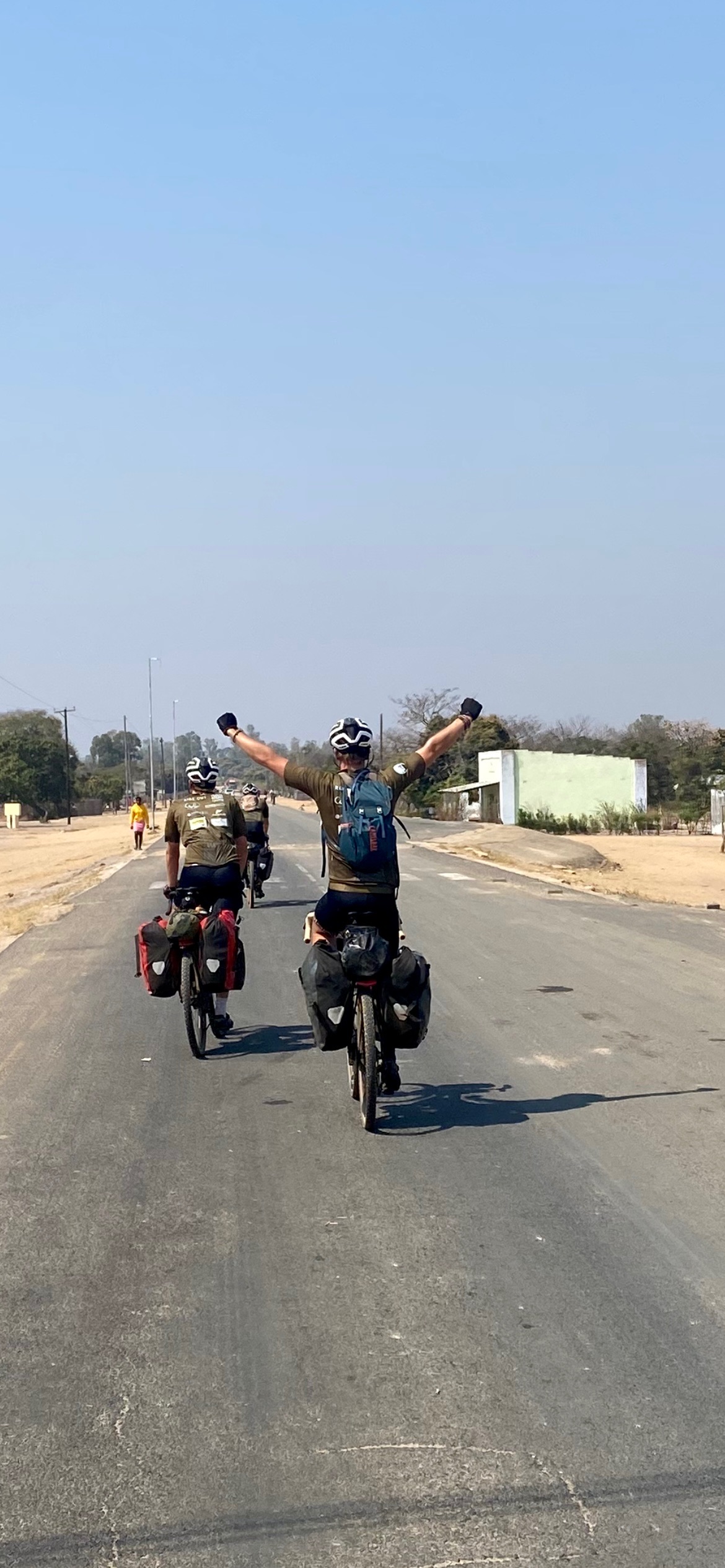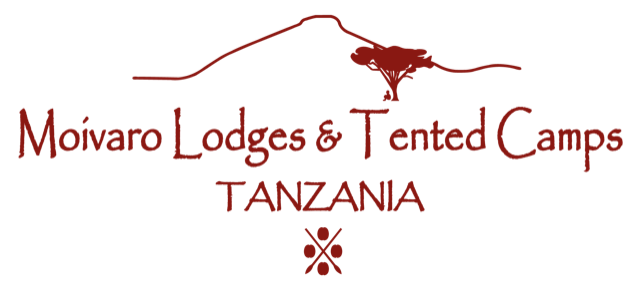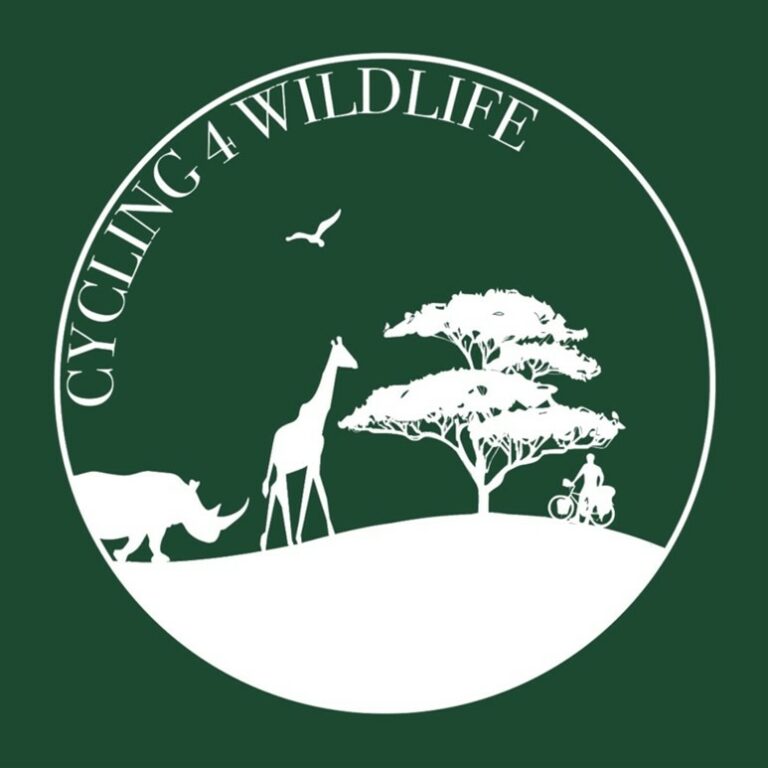The last few miles
After covering nearly 300 kilometres in two days (on the second day we cycled just short of 200 kilometres), we reached Mongu on the 18th of August. All that lay between us and our finish line in Kalabo was the Barotse floodplain: a distance of just 70 kilometres. That day we would cross two rivers. First, the mighty Zambezi and second, the Luanginga, a river comparatively unremarkable, both in size and reputation. Yet, for us it marked the finish line of an epic 5,000-kilometre journey. When we reached the river, a driver from Liuwa was waiting to pick us up. Strangely, after all the anticipation, reaching the finish line felt a bit underwhelming. All those days of relentless cycling, the endless roads, the punctures, and moments when we absolutely hated being on our bikes – all of that had come to an end so abruptly. Was this really it?

When we crossed the river per ferry, a bridge across it was being built, apparently with Chinese money. It was hard to tell why, since behind the river, the tar road stopped immediately, giving way to a dirt road leading into nowhere. When I say, “into nowhere”, I mean it quite literally: across the river, all one finds is vast expanses of loose sand, stretching far into Angola. Even for skilled driver in a Land Cruiser, the terrain poses a serious challenge. It took more than an hour and a lot of diesel to reach the park’s head office, just outside the park’s official boundaries. It was clear why not many people visit Liuwa Plain: it is almost impossible to get there.
Arrival in Liuwa
Upon arrival at head office, we met Deon Joubert, the park manager, and his wife Anèl, who gave us a warm welcome. Like many of the other park managers we had met, Deon too was an ex-military man and had spent much of his career in conservation working for South African National Parks. Anèl, on the other hand, had worked in the hospitality industry, managing luxury lodges across Africa. The two had only married recently, here in Liuwa Plain.
From the beautiful office building, our journey into the heart of the park continued. The landscape of Liuwa was unlike anything we had seen on our journey so far. Whereas most of the parks we visited featured woodland savannah, we now found ourselves on wide open plains, reminiscent of the Serengeti. Perhaps a little sentimental from reaching our final destination, Thomas remarked: ‘It feels like we have reached the end of the Earth.’ And I must say, that’s precisely how it felt. Of course, rationally we knew that these plains continued into Angola, meeting mountains and deserts, behind which lay the vast Atlantic Ocean. Yet, emotionally, it was indeed as if the world stopped here, along with our journey.
Hidden away in a small piece of woodland on a slight rise in the landscape, lay a camp called Matiamanene, where AP host their own guests. Due to its slightly elevated position, which prevented roots from flooding, Matiamanene stood out as one of the few places in Liuwa where trees could grow. The camp, hidden under the canopy, was beautiful but simple, with basic yet elegant tents, a communal space both indoors and outdoors, as well as a well-equipped kitchen. The camp was run by Mushi who, despite his seniority, refused to call us anything other than “boss”. Since it was impossible to make him call us by our names, we figured the only way to avoid an awkward situation was to call him “boss” as well. This he found very amusing.

Back in 2019, a BBC film crew had stayed in Matiamanene to capture Liuwa’s cheetahs as part of their Dynasties series. This time, another a film crew was staying at Matiamanene, albeit a very different one. This film crew was not your typical bunch of bearded, slightly overweight men, but a French family of five, consisting of father Philippe, mother Lori, and their three children. Philippe and Lori had spent a great portion of their lives travelling the world, using film as their medium to raise awareness for environmental and social injustice. But while most parents would have settled down after having children, the Lemarchands just kept going, bringing their children along to places like India and Brazil. I’m not sure whether I would have liked that as a child but, having seen much of the globe in their early years, the Lemarchand kids were certainly wise for their age. Especially six-year-old James, who spoke fluent French, English and Portuguese, made a deep impression on us.
The Induna
Due to the remoteness of Matiamanene, our schedule in Liuwa was pretty laid-back. Most of our days were spent reading and playing cards, though the experiences we did have really stood out. One such memorable experience came when we watched a few locals spearfishing at King’s Pond. After sitting there for a while, we decided to cross the cultural and physical boundary and asked if they would teach us how to catch a butter barble, the fish they were after. At first they seemed a little suspicious of us, but in the end, despite the language barrier, we all had a good laugh as we tried and failed miserably to catch a fish.

Another memorable event was our audience with Induna Mundandwe, one of Liuwa’s 13 Indunas, or tribal leaders, whom we under the shade of a large tree in his village. Here, he proudly shared with us the history of his people and discussed the challenges and benefits that come with living inside a national park.
Some five hundred years ago, the Lozi, also known as the Barotse people, embarked on a migration from the Congo, eventually settling in the Barotse floodplain. The people who live in Liuwa Plain today survive in much the same fashion as their ancestors did all those centuries ago. This way of life is mostly shaped by the land which, subject to floods during some months of the year and prolonged droughts during others, is unsuitable for crop cultivation, making extensive pastoralism and spear fishing the only means of survival.
However, while the people in Liuwa maintained their traditional way of life, the world around them underwent profound changes. Following a 30-year occupation by the Makololo people from Lesotho, which ended with the 1864 revolt led by king Sipopa Litangu, another foreign power came knocking at the door: the British Empire. In the 1880s, diamonds were found on Barotse land, which drew the interest of a man who was always found in the vicinity of diamonds, Cecil Rhodes. In 1890, Rhodes and his British South Africa Company convinced king Lewanika to sign a treaty that made Barotseland British protectorate. Sadly, it wasn’t long before King Lewanika felt he had been deceived by Rhodes, after which he made asked Queen Victoria for help, but to no avail.
Fortunately, King Lewanika also made decisions that turned out more favourable. Recognising the Barotse’s deep reliance on their natural environment for survival, King Lewanika appointed his subjects as custodians of Liuwa Plain, setting one of the earliest examples of conservation policy in Africa. Sadly, however, external pressures took their toll on the landscape. The 40-year-long war in neighbouring Angola brought a continuous influx of people from the west who looked at the massive wildebeest herds for survival. This had a devastating effect on the wildebeest population, which plays a key role in shaping the Liuwa ecosystem. Meanwhile, predators were wiped out, resulting in the killing of all but one lion – the lioness that came to be known as Lady Liuwa.
The war in Angola meant not just an influx of people but also of weapons, the induna told us. With AK-47s instead of homemade muzzle loaders, poachers became significantly more efficient, and to make matters worse, the automatic rifles were used not just on wildlife but also on people.
So, when African Parks took over in 2004, they promptly implemented an arms amnesty programme, providing people the opportunity to surrender their weapons without fear of prosecution. While the amnesty programme was an early success, scepticism about the new management persisted among the local population. Many feared they would be displaced from the landscape, mirroring the fate of communities in other parts of Africa. Of course, this did not happen, and today, Liuwa Plain is home to more than 10,000 people living legally inside the park, although we also heard figures of 12,000 and 14,000. In any case, this number is growing rapidly, which translated to increased pressure on wildlife. ‘We believe that the more children you have, the better you are,’ the Induna said with a big smile, but he too acknowledged the problems this creates.
To mitigate human-wildlife conflict, a compensation scheme has recently been introduced., Livestock owners now receive compensation when their animals fall victim to predators. However, claims are only valid if farmers adhere to specific rules, such as securing their animals in a kraal at night and limiting their cattle’s range to within five kilometres of the village. This approach aims to protect both livestock and predators, though a recent incident serves as a reminder that challenges persist.
While the lions in Liuwa primarily target wild prey, there was one lion that had developed such a strong taste for cattle that intervention became necessary. Pushed out of the pride by his father, this young male had embarked on a solitary journey into Angola, covering more than 800 kilometres. During his time there, he had picked up a bad habit of preying on cows instead of antelope, probably due to the lack of game available. Upon his return, he continued to target livestock. After 15 cows had been killed and local farmers had made threats to poison the entire pride, park management saw no other option but to put the young male down.

Searching for wild dogs
To prevent such things from happening, the Zambian Carnivore Programme (ZCP) is constantly busy monitoring Liuwa’s carnivores. Coincidentally, the person working for ZCP in Liuwa was a Dutchman named Daan Smit. After finishing his studies at Van Hall Larenstein in the Netherlands, Daan travelled to Zambia to volunteer for six months. He probably didn’t know it at the time, but Daan would end up staying for over a decade, and he has no plans to leave Liuwa Plain any time soon.
On our last night in Matiamanene, Daan appeared after dinner with an exciting proposition: to join him the next morning on a mission to locate the wild dogs.[1] The plan was to catch up with the pack before dawn and observe their morning hunt. This meant a 3 a.m. wake up, but of course, we eagerly agreed. En route to the dogs, located in the far north of the park, Daan shared some insights into Liuwa’s carnivore population. At present, there were twelve wild dogs, sharing the landscape with 17 lions, 22 cheetah and 350 hyaenas. That may sound like a substantial figure, but when you consider the fact that there are between 4000 and 5000 domestic dogs living inside this “wilderness” area, the perspective shifts.
When we eventually found the wild dogs, however, we forgot all of that. Though we did not get to watch them hunt (apparently, they had eaten their bellies full the night before), we stayed with the dogs for two hours, observing the intricacies of their morning rituals. After waking up, each dog in the pack greeted its companions individually, a ritual that solidifies the cohesion in the tight-knit pack. This cohesion is essential for the wild dogs’ hunting strategy, which relies on strictly coordinated teamwork. This cooperation makes wild dogs the most efficient among all of Africa’s carnivores, with 80 per cent of hunts resulting in a kill (lions, in comparison, are successful just 30 per cent of their hunts). Yet, even the most efficient carnivores occasionally miss an opportunity, as we witnessed that morning. Two duikers with limited situational awareness got the fright of their lives as they stumbled upon the pack in the high grass. What followed was a brief chase, which saw the duikers narrowly escaping.
As we drove back to camp, the fun wasn’t over yet. We also passed the pride of lions, where we found out that two of the females were pregnant. Once he saw this, Daan got really excited. As it turned out, the BBC film crew had expressed their interest in following Liuwa’s lions for another season of Dynasties if two of the pride’s lionesses were to be pregnant.

Back to Lusaka
Though the knowledge that we might soon be able to see Liuwa on television provided us with some solace, the drive back to Lusaka still felt strange. All the distance we had cycled over the course of five days, we now covered in a matter of hours. We felt proud of our achievements, but what did they mean in the grand scheme of things? Yes, we had reached the finish line after cycling 5,000 kilometres, but we were still miles off our target of €100,000 (and we still are). Sure, we had gained a modest following on Instagram, but did we really “raise awareness”? These thoughts raced through my mind as we passed by the spots where we had taken a water break, devoured a roll of Eet-sum-mors, or dealt with a toilet emergency. I recognized the places where I had resented our endeavour, but also those where we had burst out laughing, and those moments far outnumbered the former.
All that remained now were a few days in Lusaka, before we would part ways: Thomas and I would board a flight back home, while Jan and Huib would fly to South Africa for a two-week adventure exploring Kruger with their girlfriends. During these last few days, we stayed at the house of Sander Donker, a distant family friend of Jan’s and mine who runs a tobacco factory in Lusaka. Our stay with him not only included a tour of his factory but also an introduction to Lusaka’s nightlife. Although I don’t remember much of our last night with Sander, I certainly do remember the Flaming Lamborghinis, which I still felt burning as Thomas and I said good-bye to Jan and Huib at the airport the next morning. Perhaps that was for the better, as it masked all the emotions I felt at that moment.

[1] Nerd fact: Wild dogs, also known as painted wolves, are actually neither dogs nor wolves. While wolves, along with jackals and coyotes, are classified within the Canis genus (with dogs, Canis lupus familiaris, being the domesticated subspecies of the wolf, Canis lupus lupus), wild dogs are scientifically categorized as Lycaon pictus, placing them in a distinct genus. Interestingly, the genus name Lycaon has its roots in Greek mythology. As the story goes, the Greek king Lycaon of Arcadia committed a terrible act by killing and cooking his own son, Nyctimus, and then serving him to Zeus in an attempt to find out if Zeus was sufficiently all-knowing to recognize human flesh. Outraged by this wicked deed, Zeus turned Lycaon into a wolf, and brought Nyctimus back to life.

















